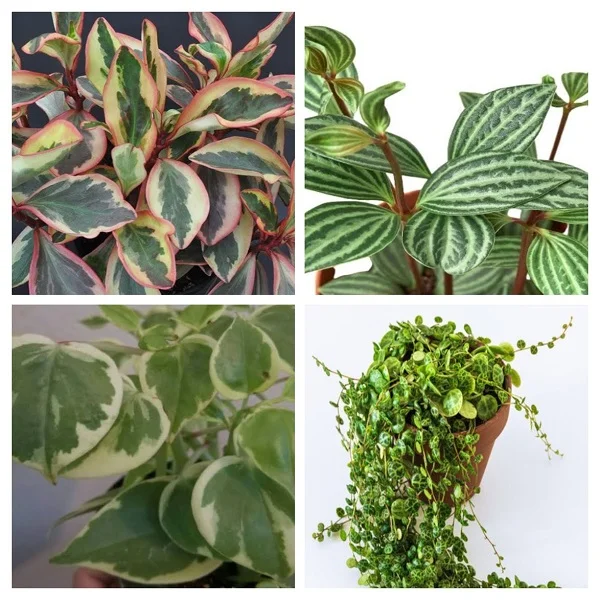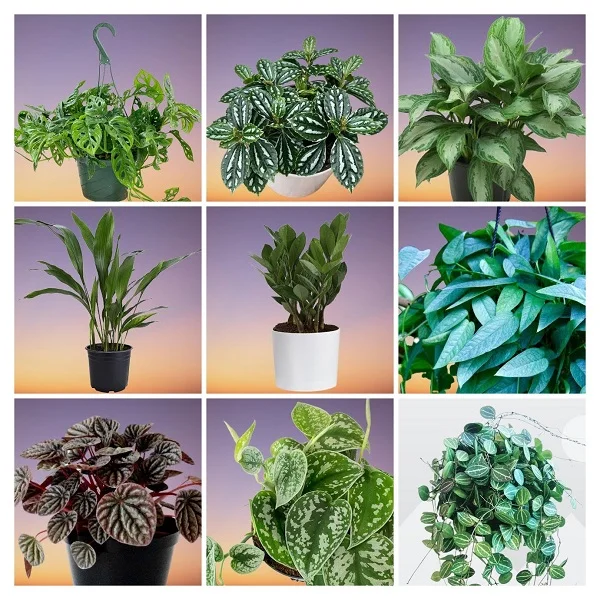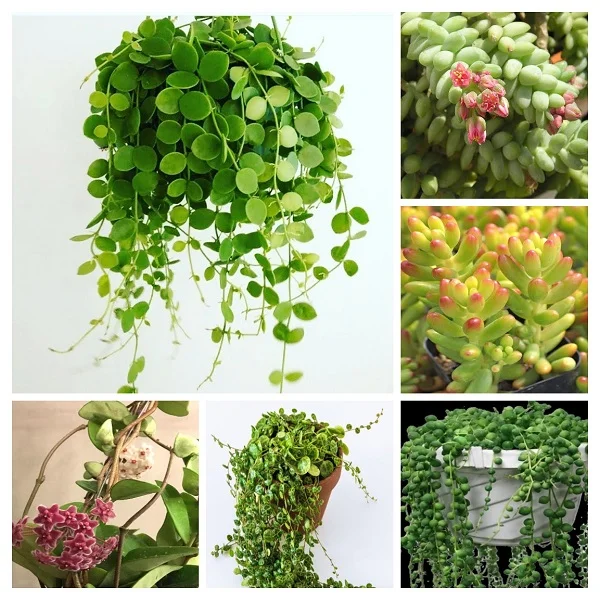Peperomia Ginny (Peperomia clusiifolia) Indoor Care, Propagation, Problems and Solutions
Some links in this post may be affiliate links
Peperomia Ginny (Peperomia clusiifolia) thrives in medium to bright indirect light, warm and humid conditions and moderately moist, rich, well-drained soils coupled with monthly feeding in the growing season.
Peperomia clusiifolia also called Peperomia Jelly, Peperomia Red-edge or Peperomia Tricolor is among the popular Peperomia varieties and bears fleshy, oval-shaped leaves that are pointed at the tips.
The leaves are often light green with darker green coloring in the center and red or pink edges. They feel like jelly to the touch and hence the common name, 'Peperomia Jelly'.
Peperomia Jelly is ideal for a hanging basket, tabletop, desktop, pedestal or plant shelf where the trailing stems can cascade beautifully down the sides of the pot. It is one of the best low-light plants for any space in the home or office.
The leaf shape and growth pattern of Peperomia Red-edge highly resemble those of Peperomia obtusifolia (Baby Rubber Plant).
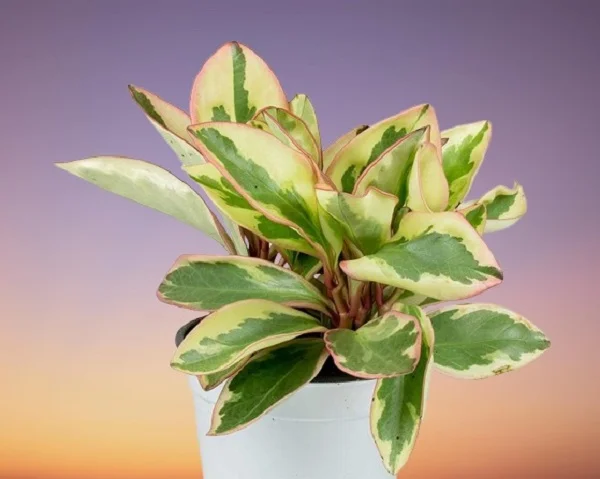
Botanical name: Peperomia clusiifolia
Family: Piperaceae
Common names: Peperomia Ginny, Peperomia Jelly, Peperomia Red-edge, Peperomia Tricolor
Origin
Peperomia clusiifolia is native to the West Indies and Mexico.
Is Peperomia Ginny toxic?
Peperomia clusiifolia like other Peperomia Plants is non-toxic to humans and pets. They are pet-safe plants for the home, office and other spaces.
Where to Buy
Are you looking to acquire Peperomia Red-edge for your collection? You may get these plants online from Amazon (Link to Amazon).
How do you care for Peperomia clusiifolia indoors?
Care for Peperomia clusiifolia indoors entails giving it medium to bright indirect light (filtered light), average warmth of 15-260C, humidity of 60-70% and moderately moist, fertile, well-drained soil coupled with monthly feeding during the growing season.
Peperomia Ginny care requires regular pruning to keep the plant neat, to encourage a bushy compact growth as well as minimize pest and disease infestations. Repotting is only needed when the plant becomes extremely pot-bound as it grows best when the roots are confined. Keep reading for more on these growing conditions and how to achieve them.
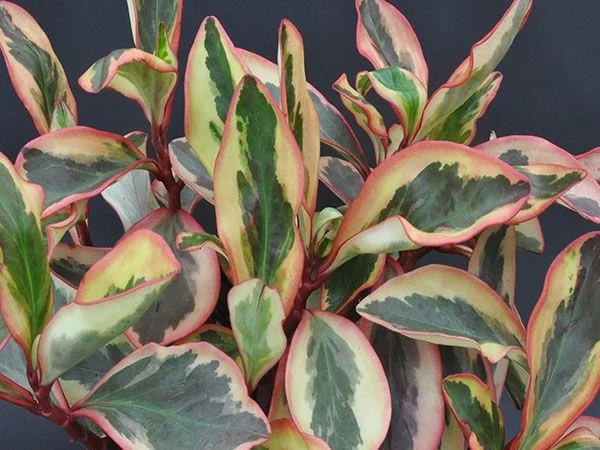
Watering
How often should I water my Peperomia Ginny?
Do not water Peperomia Ginny on a schedule to avoid either overwatering or underwatering where both can be detrimental to the growth of the plant.
Water your Peperomia Ginny liberally in spring and summer and allow the top 2-3 inches of soil to dry out between waterings. Keep the soil moderately moist and avoid soggy soil to prevent rotting and leaf drop.
Significantly decrease watering in fall and winter to keep the soil barely moist as growth is minimal at this time. However do not allow the soil to dry out completely to avoid wilting; wrinkled leaves.
Use water at room temperature to avoid shocking the plant which can result in slow growth and leaf drop.
Avoid hard water as the dissolved chemical can cause brown leaf tips and edges; use rainwater or filtered water.
Ascertain that the pot has a drainage hole to prevent the soil from getting soggy as it can result in root-rot and death of the plant./p>
Light Requirements
Where is the best place to put Peperomia Ginny?
Peperomia Ginny prefers medium to bright indirect light (dappled light). Put it infront of a large, well-lit window. Keep it away from direct sunlight as it can cause scorching; brown, crispy leaves.
Too little light will result in leggy plants and loss of leaf color. If the natural light is not adequate, you may use grow lights to supplement it.
Regularly, turn the pot to ensure that the plant receives light on all sides for uniform growth and also prevent leggy growth.
Temperature and Humidity
Peperomia clusiifolia flourishes in an average warmth of 15-260C. Keep it away from cold drafts as they can cause reduced growth and leaf drop.
Peperomia Ginny grows best in a humidity of 60-70%. Set pot on a wet pebble tray or use a cool mist humidifier to raise humidity. You may also grow the plant in a terrarium as high humidity can be maintained.
Do not mist the plant and make sure that there is good air circulation to discourage fungal diseases.
Potting Soil
The best soil for Peperomia clusiifolia should a light, well-draining soil mix that prevents excess moisture retention. A blend of 50% peat-based potting mix for moisture balance, 30% perlite for improved aeration, and 20% orchid bark or sand for better drainage is ideal for this plant.
Fertilizer
What is the best fertilizer for Peperomia Ginny?
Feed your Peperomia Ginny with a balanced, liquid fertilizer once a month during the growing period (spring and summer) to promote a lush growth.
Growth is reduced during the cold season (fall and winter), therefore, do not feed it as it can lead to fertilizer burn and death of the plant.
Repotting
When to repot Peperomia clusiifolia?
Repot your Peperomia clusiifolia every 2-3 years during the growing season, only when the plant has become extremely pot-bound; it grows best when the roots are confined.
Use a pot one size larger than the current one and make sure it has a drainage hole to prevent root-rot. Take a look at these pots with drainage holes on Amazon.
Pruning & Grooming
Pruning Peperomia Ginny involves:
- Regular removal of dead foliage to maintain the plant tidy and also minimize pest and disaese infestations.
- Cutting back the stems during the growing season to rejuvenate growth; as the plant ages, it becomes straggly.
Regularly clean the leaves by damp-wiping with a soft cloth to get rid of dust as well as discourage pest and disease infestation.
Peperomia clusiifolia Propagation
Peperomia clusiifolia (Peperomia Ginny) is propagated at the beginning of the growing season from leaf cuttings, stem cuttings or by plant division.
1. Peperomia clusiifolia propagation from leaf cuttings in water
The leaf cuttings root easily, therefore there is no need for a rooting hormone.
Take leaf cuttings from a healthy plant and ensure each leaf cutting has a petiole.
Allow some time for the formation of a protective callus tissue over the cuts of the leaf cuttings to prevent rotting.
Place the leaf cuttings in a jar of clean plain water and change the water every 5-7 days.
Position the set up in warm well-lit place until growth begins at the base of the cuttings leaf petiole.
Allow enough time for substantial growth of the roots and new leaves.
Transfer the rooted cuttings to individual pots and place in a warm, well-lit place. For a fuller plant, transfer several plants in one pot.
Maintain the soil moist until the new plants are well established after which you can begin routine care.
2. Peperomia clusiifolia propagation from stem cuttings
The stem cuttings root easily, therefore, there is no need for a rooting hormone.
Take stem cuttings of about 4-5 inches length from a healthy plant and ensure each cutting has at least 2 sets of leaves.
Insert the cuttings in moist rooting soil and place in warm shaded place.
Maintain the soil moist until new growth emerges and substantial growth has been observed.
Transfer the rooted cuttings to individual pots and begin routine care. For a fuller plant, transfer several cuttings in one pot.
3. Peperomia clusiifolia propagation by plant division
Water the plant thoroughly at least one day before to make it easier to divide and also hasten establishment.
Take the plant out of its pot and divide it into several sections.
Pot these sections in individual pots and place in a warm, well-lit place away from direct sunlight.
Maintain the soil moist until new growth emerges on the plant sections.
Allow the new plant to be well established before transplanting after which routine care can begin.
Related Content: How to Propagate Radiator Plants (Peperomia) by 4 Easy Methods

Peperomia clusiifolia Problems & Remedies
Peperomia clusiifolia (Peperomia Ginny) problems are dropping leaves, brown leaves, yellow leaves, drooping leaves, brown leaf tips, leggy growth, wrinkled leaves, pests and diseases among others. Keep reading for more on these problems and how to fix them.
Dropping leaves
Why are the leaves dropping on my Peperomia Ginny?
Your Peperomia Ginny leaves are dropping due to cold drafts, inconsistent watering, and soggy soil.
How to fix it
Cold drafts: Move the plant to a warmer spot away from cold drafts and maintain a warmth of 15-260C.
Inconsistent watering: Water when the top 2-3 inches of soil to dry out but do not allow the soil to dry out completely.
Soggy soil: Use well-draining soil and a pot that has a drainage hole.
Check out these 12 reasons why Peperomia is dropping leaves and their remedies
Brown leaves
Why is my Peperomia Ginny turning brown?
Some of the causes of brown leaves on your Peperomia Ginny are inconsistent watering, temperature stress, direct sunlight, and aging.
How to fix it
Inconsistent water: Water when the top 2-3 inches of soil dry. Never allow the soil to dry out completely.
Temperatute stress: Protect the plant from drafts emanating from AC units, heat sources, windy doors and others.
Direct sunlight: Keep the plant away from direct sunlight or use a light curtain to filter the light.
Aging: As the plant matures the lower leaves turn brown and fall off.
Yellow leaves
Why are my Peperomia Ginny leaves turning yellow?
The main causes of yellow leaves on your Peperomia Ginny are underwatering, overwatering, soggy soil, too little light and direct sunlight.
How to fix it
Underwatering: Water when the top 2-3 inches of soil dry out but do not allow the soil to dry out completely.
Overwatering: Do not water on a schedule. Water only when the top 2-3 inches of soil feel dry.
Soggy soil: Use a pot with a drainage hole and well-draining soil.
Too little light: Move the plant to a brighter spot or use a grow light if the natural light is not enough.
Direct sunlight: Position the plant in a shaded place or instal a sheer curtain to filter the sunshine.
Drooping leaves
Drooping leaves on Peperomia clusiifolia is due to dry air, incorrect watering, soggy soil, salts buidup, and temperature stress.
How to fix it
Dry air: Use a humidifier or a wet pebble tray to heighten humidity. Group the plants together to create a humid environment.
Incorrect watering: Do not water on a schedule. Water when the top 2-3 inches feel dry and do leave the soilball to dry out completely.
Soggy soil: Ensure that the pot has a drainage hole and the soil is free-draining.
Salts buildup: Regularly flush out accumulated salts from the soil by running a stream water until it drains through the drainage hole.
Temperature stress: Keep the plant away from drafts coming from AC units, windy doors, drafty windows, heat sources and others.
Take a look at these 14 reasons for Peperomia drooping leaves and how to fix them
Brown leaf tips
Brown leaf tips and edges on Peperomia Ginny are are caused by temperature flactuations and low humidity.
How to fix it
Temperature flactuations: Keep the plant away from drafty windows, windy doors, hot vents, air conditioning units and others.
Low humidity: To increase humidity, set pot on a wet pebble tray or grow the plant in a well-lit bathroom and other moist areas in the home.
Leggy stems
Leggy stems on Peperomia clusiifolia are due to low light and overfertilizing.
How to fix it
Cutback the stems to rejuvenate growth and encourage a bushy compact growth.
Low light: Position the plant in a brighter spot where it will receive medium to bright indirect light or instal a grow light if you do have adeqaute lighting in your home.
Overfertilizing: Feed monthly in spring and summer but do not feed in fall and winter.
Wrinkled leaves
Wrinkled leaves on Peperomia clusiifolia is caused by dry air and salts buildup.
How to fix it
Dry air: Set pot on a wet pebble tray or use a cool mist humidifier to raise humidity for the plant.
Salts buildup: Flush out the salts from the soil by running a stream of water through the soil until it comes out through the drainage holes.
Pests
Common pests in Peperomia Ginny are spider mites, whiteflies, scale insects and mealybugs.
How to fix it
- Isolate the affected plant to prevent spread to the other plants.
- Treat the infested plant with neem oil or insecticidal soap as per the manufacturers recommendations.
- Regularly check underneath the leaves for these pests and carry out timely control measures.
- Keep the plant properly pruned to discourage their infestation.
Diseases
Peperomia clusiifolia is prone to the following two diseases:
1. Root-rot disease which is prevalent in soggy soil. It is characterized by wilted and discolored leaves and corky swellings under the leaves.
How to fix it
- Carefully slip the plant out of its pot and inspect the roots.
- Trim brown-black mushy roots and treat the healthy roots with a copper-based fungicidal solution as indicated on the label.
- Disinfect the pot with the fungicidal solution or use a fresh pot to repot the plant in fresh, well-draining soil.
- Do not water the plant immediately and keep it dry for 5-7 days before you can resume watering.
- Use a pot with a drainage hole and well-draining soil at all times to prevent the soil from soggy.
- Lessen watering in fall and winter as growth is slowed at this time; keep the soil slightly moist.
2. Leaf spot disease which is promoted by warm, damp conditions. It is characterized by brown, moist spots on the foliage.
How to fix it
- Remove and burn the affected parts to reduce the risk of spread to the rest of the plants.
- Spray the affected plant with a systemic fungicide and ensure to follow the instructions on the label.
- Keep the plant on the dry side and do not mist it or wet the foliage during watering.
- Regularly damp-wipe the leaves with a soft cloth to discourage the disease.
Conclusion
Peperomia Ginny (Peperomia clusiifolia) is a low-maintenance, visually striking plant that thrives in indoor environments. By providing proper light, soil, watering, and occasional pruning, your plant will grow beautifully. Plus, with its easy propagation methods, you can expand your collection effortlessly.
You liked it? Share on social media.
Related Content
Amazon Associates Disclosure
Homeplantsguide.com is a participant in the Amazon Services LLC Associates Program, an affiliate advertising program designed to provide a means for sites to earn advertising fees by advertising and linking to amazon.com.



